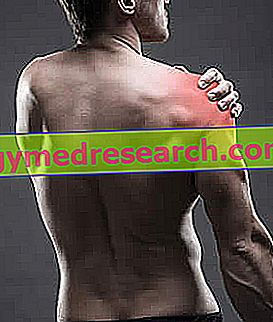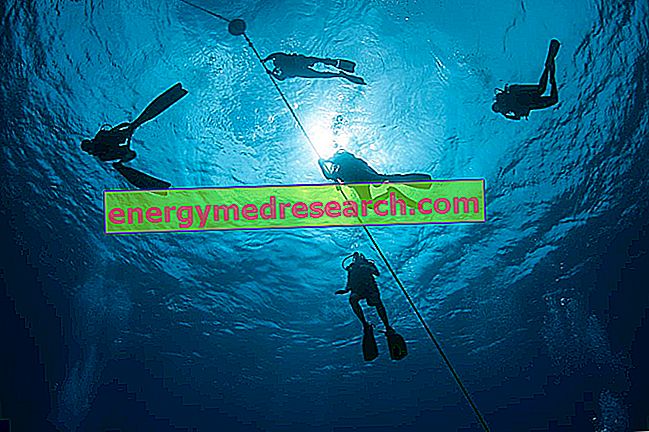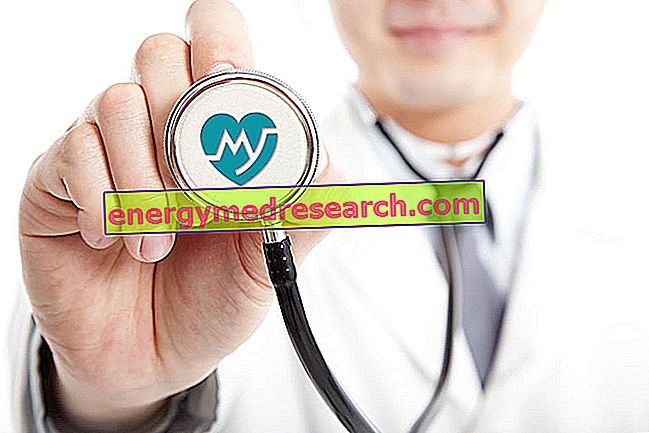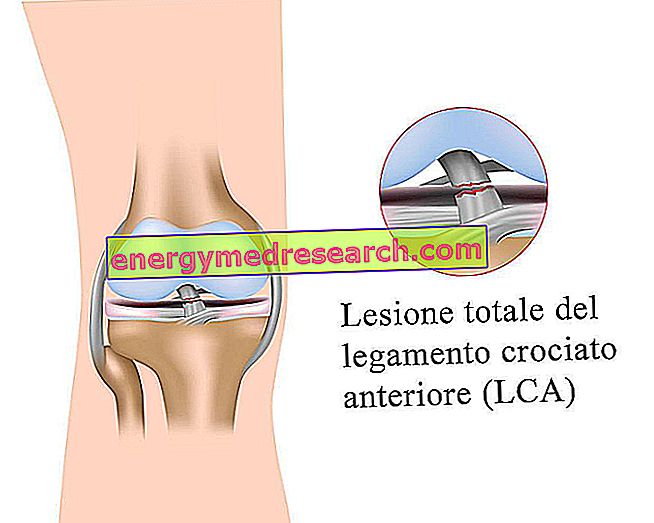Stretching (also called elongation) is a medium-sized muscle lesion, which can affect one or more skeletal muscles or part of them.
It is more severe than a contracture (in that it also has a hematic effusion) and is less severe than a tear (unlike the latter it has no interruption of muscle continuity).

The body has a specific defense mechanism against this type of trauma. It is called a stretch reflex. It consists in the instantaneous and immediate contraction of the affected muscle associated with the relaxation of the antagonist muscles. The impulse is generated by the mechanical stress of the neuromuscular spindles present in the stretched muscle. However, it is not always fast or effective enough to prevent tissue damage.
Muscle stretching is a fairly common injury in the sports field and mainly involves the disciplines of: elastic force, maximal strength, explosive force, speed and speed.
What to do
- Prevention: it is possible to reduce the probability of stretching by adopting a series of useful measures (see Prevention). In short:
- Warm up your muscles well.
- Possess a training base.
- Practice activities appropriate to your condition.
- Do not have muscle-joint pathologies or imbalances in the kinetic chain.
- Identify the symptomatology (see Muscular Tear Symptoms):
- Sharp and sudden pain.
- Muscle spasm and motor disability.
- Stop the sport activity after the event.
- Carry out a diagnosis to identify the severity of the stretch and rule out more severe injuries. It is advisable to contact the emergency room directly. The estimate is made through:
- Palpation and functional verification: it is necessary to immediately check the extent of the damage and to exclude fractures, distortions, etc.
- Ultrasound type medical imaging: it is more specific and provides a detail on the vastness and severity of muscle stretching.
WARNING! The diagnosis is very important as certain aspects of the treatment related to stretching and tearing are diametrically opposed to the contracture.
- Application of the RICE protocol It is the English acronym of the words rest (rest), ice (ice), compression (compression), elevation (elevation):
- Rest: total of at least 2-3 weeks, not only from the sport but from any physical activity that affects the affected district.
- Ice: in the form of compresses to be applied in the inflamed area.
- Compression: useful in the application of the pack and also in the form of wrapping.
- Elevation: if possible, the stretched muscle should be held above the level of the heart to facilitate venous return.
- Under medical prescription, take anti-inflammatory and muscle relaxant drugs (see below Pharmacological treatments).
- Adopt specific medical therapies (see Medical Treatments below).
- Eventually, practice autonomous stretching under the advice of the physiotherapist.
What NOT to do
- Do not warm up before physical activity, or do it inadequately (insufficient, inappropriate).
- Stretching "cold" before the activity, especially passive and forced.
- Practice activities without an athletic base.
- Try your hand at sports other than your own at excessive intensity.
- Ignore the presence of pathologies or kinetic disorders.
- Repeated muscles undergo trauma.
- Insist on the activity even in the presence of obvious symptoms.
- Do not consult a doctor for a certain diagnosis.
- Do not apply the RICE:
- Neglecting rest after the injury by preparing for relapses.
- Do not respect other specific medical therapies and precautions (see above).
- Do not respect the drug therapies prescribed by your doctor.
WARNING! Stretching in the healing phase is an activity that can confer benefits or worsen the damage, depending on the specific case and method.
What to eat
There is no useful diet to fight muscle strains directly. However, it could be useful to increase the supply of anti-inflammatory nutrients:
- Omega 3: are eicosapentaenoic acid (EPA), docosahexaenoic (DHA) and alpha linolenic acid (ALA). The first two are biologically very active and are contained above all in: Sardinian, mackerel, bonito, alaccia, herring, alletterato, ventresca of tuna, needlefish, algae, krill etc. The third one is less active but is a precursor of EPA; it is mainly contained in the fat fraction of certain foods of vegetable origin or in the oils of: soy, linseed, kiwi seeds, grape seeds, etc.
- Antioxidants:
- Vitaminics: the antioxidant vitamins are carotenoids (provitamin A), vitamin C and vitamin E. Carotenoids are contained in vegetables and red or orange fruits (apricots, peppers, melons, peaches, carrots, squash, tomatoes, etc.); they are also present in shellfish and milk. Vitamin C is typical of sour fruit and some vegetables (lemons, oranges, mandarins, grapefruit, kiwi, peppers, parsley, chicory, lettuce, tomatoes, cabbage, etc.). Vitamin E is available in the lipid portion of many seeds and related oils (wheat germ, maize germ, sesame, etc.).
- Minerals: zinc and selenium. The first is mainly contained in: liver, meat, milk and derivatives, some bivalve molluscs (especially oysters). The second is contained above all in: meat, fishery products, egg yolk, milk and dairy products, fortified foods (potatoes, etc.).
- Polyphenols: simple phenols, flavonoids, tannins. They are very rich: vegetables (onion, garlic, citrus fruits, cherries, etc.), fruit and related seeds (pomegranate, grapes, berries, etc.), wine, oilseeds, coffee, tea, cocoa, legumes and whole grains, etc.
What NOT to Eat
- Alcoholic: ethyl alcohol has a diuretic action and interferes with drug metabolism, reducing the effect of the active ingredients.
- Excess of omega 6 fatty acids or incorrect omega 3 / omega 6 ratio (for the benefit of the latter). They could exert a pro-inflammatory effect. It is good practice to limit the introduction of foods rich in linoleic, gamma-linolenic, diomo-gamma-linolenic and arachidonic acid, such as: seed oil (especially peanuts), most of dried fruit, certain legumes, etc. At the same time it is necessary to increase the intake of omega 3 (see What to Eat above).
Natural Cures and Remedies
- Cryotherapy: reduces blood flow, limiting any blood spill.
- Bandages: useful in preventing swelling.
- Elevation: necessary to facilitate venous return.
Pharmacological care
In the treatment of muscle contractures, drugs are little used. On the contrary, they represent a highly used solution for stretching and tearing.
Your doctor may recommend taking:
- Non-steroidal anti-inflammatory drugs (NSAIDs): for systemic or topical use (ointment, gel or cream):
- For systemic use - tablets and suppositories:
- Ibuprofen (eg Arfen®, Moment®, Brufen®, Nurofen®)
- Diclofenac (eg Voltaren®).
- Naproxen (eg Aleve®, Naprosyn®, Prexan®, Naprius®).
- For topical use - creams, ointments and gels:
- Ibuprofen lysine salt at 10% (for example Dolorfast®).
- Ketoprofen 2.5% (eg Fastum gel®, Ketoprofen ALM®, Steofen®).
- Diclofenac (eg Voltaren®).
- Muscle relaxants: relax the skeletal and smooth muscles. They can be oral (systemic), parenteral (injection) and topical (ointment, gel or cream). They exert their activity through a mechanism of action that involves the antagonism of the GABA-A receptor. The most used in stretching are those that act on the central nervous system:
- Suxamethonium chloride (eg Myotenlis®).
- Thiocolchicoside (eg Muscoril®, Miotens®).
Prevention
- Reach an adequate body temperature, particularly in the muscles most prone to a stretch injury; can be very useful:
- Technical clothing in the winter months.
- Specific ointments.
- Carry out heating and activation (or "approach") with the aim of:
- Increase the temperature of all the muscles used in the athletic gesture.
- "Stretch" the tissues of the structures recruited in the athletic gesture (muscle bundles, sheaths, etc.).
- WARNING! Stretching can be beneficial or harmful depending on the time, type and intensity. It is advisable to always run it hot, not immediately after strength and / or muscle exhaustion exercises and without straining or bouncing.
- Identify your training level and contextualize the performance (do not overdo it).
- Recover and compensate adequately.
- Correct or cure any joint and muscle pathologies.
- For those who run, carefully evaluate the terrain.
Medical Treatments
- Physiotherapeutic treatment: useful especially in the most serious cases. It includes a series of assessments and manipulations (passive stretching, proprioception, progressive loading, etc.), which allow for optimal progress with therapy and activity recovery.
- Tecar therapy: it is a therapeutic method that uses an electric condenser to treat muscle joint injuries. The mechanism of tecarterapia is based on restoring the electric charge in the injured cells to make them regenerate more quickly.
- Transcutaneous Electrical Nerve Stimulation (Tens): it is an analgesic electrotherapy that acts especially against pain. Send electrical impulses to the skin through electroconductive plates. These block the nerve signals of pain and stimulate the production of endorphins.
- Ultrasound: this system uses high frequency acoustic waves. It is very useful as an anti-inflammatory, stimulating edematous reabsorption and to dissolve the adhesions that are formed during healing. It produces heat and increases the permeability of cell membranes.
- Magnetotherapy: exploits the effects of the magnetic field on the body. It is applied using two solenoids directly on the muscle. It exerts a force on ferromagnetic, paramagnetic and diamagnetic molecules. The high and low frequency produces benefits if the treatment is long enough; the effectiveness of the static one is not scientifically proven. Its effects on cells, inflammation, inflammation etc. are different. It can reduce healing times up to 50% but the effectiveness changes depending on the damage.
- Laser therapy: it is a treatment that uses the rays applied directly to the affected area. The laser electron beam acts on the cell membrane and mitochondria, increasing metabolic activity, reducing pain and inflammation, creating vasodilation and increasing lymphatic drainage.
- Kinesio taping: it is more indicated for contractures and slight stretching. This system uses the traction of adhesive and elastic bandages, sometimes containing small pharmacological concentrations. They should have a draining, slightly pain-relieving-anti-inflammatory and guardian function.
- Iontophoresis: it is a form of injection without a needle. It allows a drug (in this case anti-inflammatory or muscle relaxant) to cross the epidermis thanks to the application of a continuous current.



